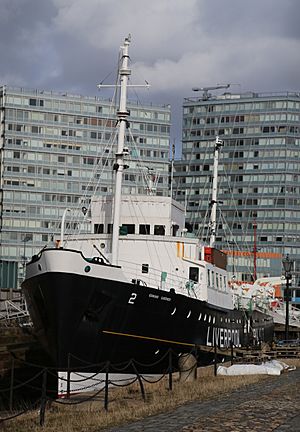MV Edmund Gardner facts for kids
 |
|
| History | |
|---|---|
| Name | MV Edmund Gardner |
| Namesake | Edmund Gardner, chairman |
| Owner | Mersey Docks and Harbour Board |
| Operator | Liverpool Pilotage Authority |
| Port of registry | Liverpool |
| Ordered | July 1951 |
| Builder | Philip and Son, Dartmouth |
| Cost | £189,230 |
| Launched | 9 July 1953 |
| Acquired | 2 December 1953 |
| Out of service | April 1981 |
| Identification |
|
| Fate | Museum ship |
| General characteristics | |
| Tonnage | 701 gross register tons (GRT) |
| Displacement | 768.36 tonnes |
| Length | 54.1 metres (177 ft) |
| Beam | 9.6 metres (31 ft) |
| Draught | 3.1 metres (10 ft) for'd: 3.7 metres (12 ft) aft |
| Installed power | 1280 bhp |
| Propulsion | Diesel-electric: 2x 6cyl, 640bhp National diesel engines |
| Speed | 14 knots (26 km/h; 16 mph) |
| Crew |
|
| Notes |
|
The MV Edmund Gardner is a special kind of boat called a pilot cutter. She was built for the Liverpool Pilot Service right after World War Two. After almost 30 years of helping ships, she became a museum ship. You can now visit her at the Merseyside Maritime Museum.
A Ship's Job: Service Career
The Edmund Gardner was ordered in July 1951 by the Mersey Docks and Harbour Board. They needed new pilot cutters because their older, steam-powered boats were getting old.
The Edmund Gardner was one of three new pilot cutters. Each boat was named after a past chairman of the board. Her sister ships were the Thomas Brocklebank and the Arnet Robinson.
The boat was built by Philip and Son in Dartmouth. She was launched into the water on July 9, 1953. The Edmund Gardner started working on the Mersey River on December 2, 1953.
Her main job was to be a floating base for pilots. Pilots are experts who guide large ships safely into and out of the Mersey River. The Edmund Gardner would spend one week at the Liverpool Bar. Then, she would spend one week at Point Lynas in Anglesey. After that, she would spend a week supplying the other two pilot cutters.
When she was on duty, the Edmund Gardner would meet ships coming into the Mersey. These ships were heading to the Liverpool Docks or the Manchester Ship Canal. She would transfer a pilot to the incoming ship. She also picked up pilots from ships that were leaving the river.
The Mersey River was very busy back then. For example, on April 15, 1960, the Edmund Gardner helped 16 ships in just eight hours. Ten ships were coming in, and six were leaving.
During her 28 years of service, the Edmund Gardner had only one small accident. In 1963, she had a minor collision with a ship called Iron Horse. Luckily, she was not seriously damaged.
Later Life: A Museum Ship
In April 1981, the Edmund Gardner stopped working as a pilot cutter. In 1982, a museum bought her. She is now one of only two pilot cutters preserved as a museum ship.
Today, you can find her in the Canning Graving Dock. This is right across from the Maritime Museum. She is also next to the Museum of Liverpool Life.
In 2014, the Edmund Gardner was chosen for a special art project. She became a "dazzle ship". This art project was organized by the Imperial War Museum's 14-18 NOW project.
Working with Liverpool Biennial and Tate Liverpool, the Edmund Gardner was repainted. The artist Carlos Cruz-Diez created a design called Induction Chromatique à Double Fréquence. This design was inspired by the dazzle camouflage used during World War One.

